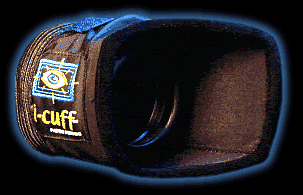 Even though the Labor Day weekend has passed by, that doesn’t mean summer is over yet. The noonday sun still sits high in the sky. The late burning orb keeps us from having to pull out a light kit for 6pm live shots, but it can also be a shot in the eye.
Even though the Labor Day weekend has passed by, that doesn’t mean summer is over yet. The noonday sun still sits high in the sky. The late burning orb keeps us from having to pull out a light kit for 6pm live shots, but it can also be a shot in the eye.
One of the most important aspects of a video camera is the viewfinder. If you can’t see what your shooting, how are you going to create award winning images? Sun-created glare in your viewfinder can be one of the biggest challenges of summer. Most cameras are equipped with a rubber eye cup that shields the viewfinder from stray sunrays. The problem is, those like myself who shoot with glasses cannot take advantage of the rubber eyecup.
Ira Raider, a freelance shooter in Philadelphia, PA has come up with an answer. The i-cuff is a nylon sleeve that fits most professional camera viewfinders creating a light-blocking hood. The cuff is large enough that glasses fit nicely within, and the felt lined edges prevent the famous “sweat circles” that appear on glasses after a long day of shooting.
The i-cuff invention has been around for a number of years, but Raider recently expanded his product line to serve the growing DV market. With some slight modifications, the i-cuff DV was born and fits most “smaller” camcorders like the Sony PD-150 and PC-110.
Having just bought a new PC-110, I was anxious to try out the new eyepiece hood. Raider sent me both a full size i-cuff PRO and an i-cuff DV. The PRO model fit perfectly on my Betacam SX viewfinder. I enjoyed the sun block, and my glasses stayed cleaner. Those off the shoulder stories out on the beach were much easier to handle (as if a day at the beach isn’t always a… day at the beach).
While shooting long interviews or press conferences on a tripod, I often pull out the front element of my viewfinder so I can see the screen from further away. Without the added magnification, I’m able to monitor the composition for the comfort of a chair instead of standing and hunching over the camera.
The snug fitting i-cuff doesn’t allow easy removal of the front element. The cuff must first be removed, which creates a multi-step process. In addition, the cuff covers up the diopter adjustment, which allows focusing of the viewfinder. If the diopter is off, the cuff must again be removed before adjustments can be made. Granted all of these inconveniences are minor, but in the “heat of battle” they can be frustrating.
 I was very excited about the i-cuff DV. My new little PC-110 has a tiny little viewfinder with no real eyepiece. The 2″ fold out LCD screen makes up for this indoors, but glare makes the screen useless in the sun. The day the i-cuff package arrived in the mail, I had just returned from a shoot at the beach where I simply guessed what the shot looked like.
I was very excited about the i-cuff DV. My new little PC-110 has a tiny little viewfinder with no real eyepiece. The 2″ fold out LCD screen makes up for this indoors, but glare makes the screen useless in the sun. The day the i-cuff package arrived in the mail, I had just returned from a shoot at the beach where I simply guessed what the shot looked like.
The i-cuff DV is huge. It probably adds a third or more to the length of the camera. Like its big brother, it allows glasses to be worn while using it. The design of the PC-110 viewfinder is for the shooters eye to be right on the viewfinder. If the eye is simply a quarter to half inch away, the viewfinder image is vignetted. Unfortunately the design of the i-cuff DV doesn’t allow you to be close enough to the viewfinder to see a good image. The benefit of the sun block is counteracted by lack of visibility. Due to these difficulties, I never used the i-cuff DV in the field on my PC-110. A colleague tried the i-cuff DV on a PD-150, and ran into the same problems.
I like the concept of the i-cuff, as a comfortable sun block hood. The design is well thought out, and the fit is clean. If glasses and glare are issues for you, this just may be your solution.
The i-cuff PRO (which fits most professional cameras) sells for $65, while the i-cuff DV goes for $39.95. For more information, check out their website at http://www.i-cuff.com.

i-cuff PRO viewfinder eyecups not only work on “big” cameras, but also great with the Zacuto and other finders for the Canon, Nikon and other DSLRs 😉